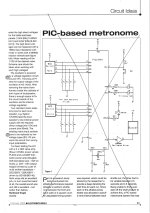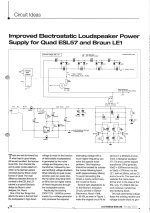Hans, it seems that some of the caps are actually 20nF.Jan,
Looking in the partlist I see 6 pieces of 10nF capacitors for C18 to C23.
So to my belief he used 20nF caps in series to get this 10nF.
I may be wrong, but 10nF is the value I used in my simulation.
Hans
Does that change your sim results as far as 100M loaded output is concerned?
Jan
For the past 5-8 years there was no US distributor in the states, This was because the previous distributor gave up - panels were failing within a year and Quad had NO panel warranty. Believe they are still being made in China BUT doing it correctly now.Interesting. I assume that's China production?
BTW A 3-year warranty on the panels doesn't seem useful, they alway fail at 10-years + ...
Do you know what they cost?
BTW2 Charles, missed you at this years' ETF!
Jan
Wanted to go to ETF but apparently wasn't on the notification list. Thought that there wasn't going to be one. By the time I found out (October) that it was actually on, had made plans to go to the Capital Audiofest instead (same weekend). Had a great time there - may bypass ETF in the future. EXCEPT I missed guys like you and the other European crazies.
Is MoFi still their distributor? In the latest 28(9)12 models, they finally changed the stator glue after 4 decades. So maybe the stator bonds won't fail so much. But they were having serious issues with the diaphragms splitting to the point that MoFi wasn't importing them for a while. I've heard repeatedly over the years that the problems are "all fixed". I'll believe it when I see it. I have a set of 2912's that I paid $1000 for that were full of broken "all fixed" panels.FWIW, Quad is back in the US with their new 2812X electrostats. Heard them two weekends ago at the Capital Area Audiofest. Sounded lovely.
Kent McCollum, the most knowledgeable Quad guy I know says that from a panel longevity perspective, they are the best yet. With a three year panel warranty!. Kent's enthused enough that he may get out of the panel rebuilding business. Quad also added refinements and beefed up the construction to where it should have been in the first place. And dropped the price.
Sheldon
I have several electrostatic voltmeters. For this stuff there are NO substitutes. However the Classic HV probe for a CRT HV is close at typically 1000 Megs. At least you will be in 10-20% of the voltage and can validate the HV supplies function. I have seen enough in this discussion to validate the electronic supply + 100M to each panel we did 30 years ago.
I have a couple of vintage Telefunken 5kV HV meters which I used in the development of the direct drive amp, but they draw up to 50uA.
I contacted several eBay sellers that offer reasonably priced and undamaged electrostatic voltmeters, but none have the matching probe available.
Jan
I contacted several eBay sellers that offer reasonably priced and undamaged electrostatic voltmeters, but none have the matching probe available.
Jan
We'll see - just HOPE they do have their act together - we NEED Quads!!!!Is MoFi still their distributor? In the latest 28(9)12 models, they finally changed the stator glue after 4 decades. So maybe the stator bonds won't fail so much. But they were having serious issues with the diaphragms splitting to the point that MoFi wasn't importing them for a while. I've heard repeatedly over the years that the problems are "all fixed". I'll believe it when I see it. I have a set of 2912's that I paid $1000 for that were full of broken "all fixed" panels.
Sheldon
I just noticed that I already used 20nF caps for all 8 eight capacitors in my sims, see #576.
This resulted in the 1.1Volt pk-pk on the bias.
Going to six 20nF and two 10nF as in #612 and like Jan reported, did not change a bit to the 1.1Volt ripple.
But making all caps 10nF, doubled the ripple to 2.2Volt.
The two versions with resp. one and two VDR's have different output impedances, and also having 8*10nF or 6*20nF+2*10nF makes a difference, as shown in the Bias voltage table below for two different loads, all versions starting with 5K25 with just the diaphragm's load.
So, the best performing version is with one VDR and 6*20nF+2*10nF.
Hans

This resulted in the 1.1Volt pk-pk on the bias.
Going to six 20nF and two 10nF as in #612 and like Jan reported, did not change a bit to the 1.1Volt ripple.
But making all caps 10nF, doubled the ripple to 2.2Volt.
The two versions with resp. one and two VDR's have different output impedances, and also having 8*10nF or 6*20nF+2*10nF makes a difference, as shown in the Bias voltage table below for two different loads, all versions starting with 5K25 with just the diaphragm's load.
So, the best performing version is with one VDR and 6*20nF+2*10nF.
Hans
Nice idea, but I guess this makes not much sense. For two reasons:Would it be possible for you to make a .wav audio recording with a duration of ca. 1 second from a rather loud pure 1KHz sine wave.
1. Make an estimation for what to expect, with very gross rounding: As from my measurement of the loading step with the neon bulb, let's assume a step of 25V (V_ignit-V_off) for the loading V_delta which accounts for a SPL intensity delta of 0.05dB. So a HV delta of 2.5V bias would produce a 0.005dB SPL delta. And the ripple of my measurements was at approx. 0.01dB, certainly also containing some (rectfied) AC line hum. This seems to be a too bad SN Ratio right from the beginning.
2. My panels are isolated from the HV supply by the neon and the parallelled capacitor. How much of the supply ripple would then finally show up as an AM modulation? Therefore in the end I would expect even less than 0.005dB ripple.
As said, before, it's just guessing. Maybe I am wrong.
But would not the voltage divider of the 47n ( // neon) and the diaphragm impedance cause most of the ripple to appear on the diaphragm?
Jan
Jan
But would not the voltage divider of the 47n ( // neon) and the diaphragm impedance cause most of the ripple to appear on the diaphragm?
Agreed. At an assumed R of lowish 1GOhms for the panels Ft would be at 0.0034Hz. This should indeed make pass most of the ripple. Shame on me 🙂
So you wiped away my objection No. 2 against measuring. Anyone objecting my 1st objection? If so, I will try measure ...
Seen that on FB. Nothing new in the promises IAG makes on build quality and technical changes for this X series.FWIW, Quad is back in the US with their new 2812X electrostats. Heard them two weekends ago at the Capital Area Audiofest. Sounded lovely.
Kent McCollum, the most knowledgeable Quad guy I know says that from a panel longevity perspective, they are the best yet. With a three year panel warranty!. Kent's enthused enough that he may get out of the panel rebuilding business. Quad also added refinements and beefed up the construction to where it should have been in the first place. And dropped the price.
All the items Kent quotes were also there for the xx05 and xx12 series.
There is nothing to be found about this release anywhere on the web ore on the official Quad UK site.
I only saw the picture of the manual with the X behind the model number to prove it's existence.
I'm very anxious to find out more about what, if anything, really changed. Until that point I'm very sceptic
It's not the neon bulb relaxation that I expect to make any trouble, but it's the ripple on the Bias voltage with a rather wide spectrum.Nice idea, but I guess this makes not much sense. For two reasons:
1. Make an estimation for what to expect, with very gross rounding: As from my measurement of the loading step with the neon bulb, let's assume a step of 25V (V_ignit-V_off) for the loading V_delta which accounts for a SPL intensity delta of 0.05dB. So a HV delta of 2.5V bias would produce a 0.005dB SPL delta. And the ripple of my measurements was at approx. 0.01dB, certainly also containing some (rectfied) AC line hum. This seems to be a too bad SN Ratio right from the beginning.
2. My panels are isolated from the HV supply by the neon and the parallelled capacitor. How much of the supply ripple would then finally show up as an AM modulation? Therefore in the end I would expect even less than 0.005dB ripple.
As said, before, it's just guessing. Maybe I am wrong.
I'll make a simulation in LTSpice with the real signals.
But if it not too much trouble, receiving a 1 sec 1Khz .wav recording would be nice to compare.
When it brings nothing, a stabilized Bias voltage doesn't seem to make sense.
Hans
Interesting, but it’s the first time I read that 50Hz could be perceived while playing soft.
With the ESL 63 I never heard 50Hz.
But we opened a box of Pandorra that’s worth to investigated in more detail.
My simulation is still to be expexted.
Hans
With the ESL 63 I never heard 50Hz.
But we opened a box of Pandorra that’s worth to investigated in more detail.
My simulation is still to be expexted.
Hans
Neither have I (nor any harmonics of 50 Hz). Does anyone know whether the ESL 57 and LE1 have a high- or a low-resistance diaphragm?
You're invitedInteresting, but it’s the first time I read that 50Hz could be perceived while playing soft.
With the ESL 63 I never heard 50Hz.
But we opened a box of Pandorra that’s worth to investigated in more detail.
My simulation is still to be expexted.
Hans
The original ESL originally has very high resistance Nylon coating 10^12Neither have I (nor any harmonics of 50 Hz). Does anyone know whether the ESL 57 and LE1 have a high- or a low-resistance diaphragm?
The LE1 uses the same panels licenced by Quad, the step-up transformers and electronics however are designed and made by Braun.
- Home
- Loudspeakers
- Planars & Exotics
- QUAD 63 (and later) Delay Line Inductors

